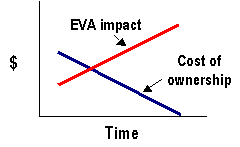Option 1: Treat as GAAP Capitalized Leases
This treatment requires that minimum lease payments be capitalized at the pre-tax cost of debt upon initiation based on the actual term of the lease. The capitalized amount is then depreciated straight-line over the life of the lease. Net Assets includes the initial valuation less accumulated depreciation. Income is adjusted by adding back rent expense, then deducting the calculated depreciation.
 This treatment
provides for an accurate assessment of the present value at the onset
and a predictable schedule of depreciation over time and results in an
EP profile similar to that of an equivalent asset if it were owned.
This treatment
provides for an accurate assessment of the present value at the onset
and a predictable schedule of depreciation over time and results in an
EP profile similar to that of an equivalent asset if it were owned.
This adjustment introduces the cost of equity into the leasing decision. Also, by producing a declining cost of ownership similar to an owned asset this adjustment makes leased assets easier to compare to owned assets.
Since the adjustment mimics GAAP treatment of certain long-term leases familiar to finance and accounting staff, the adjustment should be relatively easy to implement. Indeed, many companies use an automated model to determine the appropriate GAAP treatment for all leases. If this model is in place, the mechanics for the adjustment may require only minor additional effort.
The primary drawback of this adjustment is that the present value of minimum lease payments can be far less than the fair market value of the assets being leased. This method would always encourage shorter-term leases to minimize the present value of the lease commitment, even when the actual need may be for a longer lease term.
Decision-makers should not be swayed by the differences in present value simply due to lease terms. Rather, they should compare the benefits of the shorter lease commitment with the additional lease renewal risks.